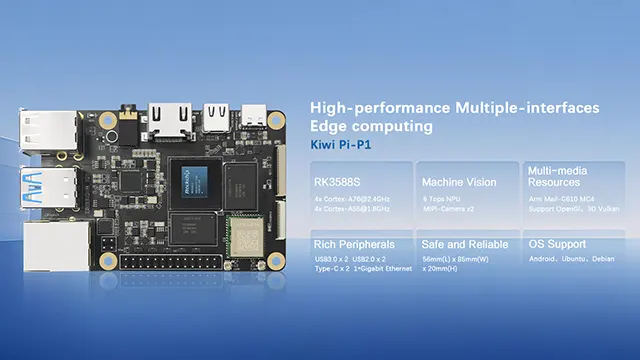
Introduction
Rockchip Single board computers (SBCs) are now vital components in contemporary embedded systems, supporting applications from industrial automation to AI-enabled edge devices. Rockchip stands out as a key player, known for producing energy-efficient yet high-performance system-on-chip (SoC) designs. Their single board computers highlight a balanced combination of high performance, energy efficiency, and multimedia capabilities, fitting well for applications in robotics, AI inference, digital signage, and IoT projects.
This comprehensive guide explores the technical strengths of Rockchip-based SBCs, their primary uses, and how they compare to competitors. A notable example is the Kiwi Pi 5, equipped with the Rockchip RK3588S, known for its excellent performance in AI and high-resolution multimedia tasks. Whether you’re an engineer selecting hardware or a developer improving embedded applications, this article provides useful insights.
Why Engineers Prefer Rockchip Single Board Computers
Rockchip processors are popular in embedded computing because of their high efficiency, robust multimedia support, and AI acceleration. Here, we outline the main reasons why developers and engineers prefer Rockchip-based SBCs.
1. Performance and Power Efficiency
Rockchip’s newest SoCs, including the RK3588 and RK3399, are fabricated with advanced process nodes like 8nm FinFET and include features such as:
- Octa-core CPU configurations (e.g., 4x Cortex-A76 + 4x Cortex-A55) for optimal multitasking.
- ARM Mali GPUs (e.g., Mali-G610) supporting OpenGL ES 3.2, Vulkan 1.2, and OpenCL 2.0 for graphics and compute workloads.
- Dedicated NPUs (Neural Processing Units) for AI acceleration, such as the 6 TOPS NPU in the RK3588.
- Hardware-accelerated video codecs (8K@60fps H.265/VP9, 4K@60fps AV1) for multimedia applications.
Compared to alternatives like Raspberry Pi (Broadcom) or Allwinner-based boards, Rockchip SBCs provide superior AI inference capabilities and multimedia performance while maintaining low power consumption.
2. Key Applications of Rockchip SBCs
Rockchip-based boards are versatile and used across multiple industries.
- AI & Edge Computing: The integrated NPU enables real-time object detection, facial recognition, and natural language processing.
- Digital Signage & Media Players: 8K video playback and multi-display support make them ideal for advertising and entertainment systems.
- Industrial Automation: Robust I/O (CAN, SPI, UART) and wide operating temperature ranges suit factory automation and robotics.
- IoT Gateways: With WiFi 6, Bluetooth 5.4, and Gigabit Ethernet, Rockchip SBCs serve as high-performance edge nodes.
3. Spotlight on the Kiwi Pi 5: A High-Performance Rockchip SBC
One of the most powerful Rockchip-based SBCs available today is the Kiwi Pi 5, which features the RK3588S SoC. Below are its key features:
Hardware Specifications
| Feature | Kiwi Pi 5 (RK3588S) | Competing SBC (e.g., Raspberry Pi 5) |
|---|---|---|
| CPU | 4x Cortex-A76 @2.2GHz + 4x Cortex-A55 @1.8GHz | 4x Cortex-A76 @2.4GHz (Broadcom BCM2712) |
| GPU | Mali-G610 MC4 | VideoCore VII (RPi 5) |
| NPU | 6 TOPS (Triple-core) | None (requires external AI accelerators) |
| RAM | 8GB LPDDR4X (up to 32GB) | 4GB/8GB LPDDR4X |
| Video Decoding | 8K@60fps (H.265/VP9/AV1) | 4K@60fps (H.265) |
| Connectivity | WiFi 6, BT 5.4, Gigabit Ethernet | WiFi 5, BT 5.0, Gigabit Ethernet |
Why the Kiwi Pi 5 Excels
- Superior AI Performance: The 6 TOPS NPU speeds up machine learning tasks without requiring additional hardware.
- 8K Multimedia Support: Ideal for high-end digital signage, medical imaging, and video analytics.
- Expandable Storage: Supports eMMC (up to 512GB) and microSD for flexible storage options.
- Rich I/O Options: Includes USB 3.0, Type-C DP, MIPI-CSI/DSI, and GPIO for sensors and peripherals.
For additional information, check out the official product page: Kiwi Pi 5 or visit the manufacturer’s website: KiwiPi.
Comparison: Rockchip SBCs vs. Competing Solutions
To better understand where Rockchip SBCs excel, let’s compare them to popular alternatives:
| Criteria | Rockchip SBCs (e.g., Kiwi Pi 5) | Raspberry Pi 5 | NVIDIA Jetson Nano |
|---|---|---|---|
| CPU Performance | High (Octa-core A76/A55) | Moderate (Quad-core A76) | Moderate (Quad-core A57) |
| GPU/Acceleration | Mali-G610 + NPU | VideoCore VII | 128-core Maxwell GPU |
| AI Capabilities | 6 TOPS NPU (On-board) | None | 472 GFLOPS (GPU-based) |
| Video Playback | 8K@60fps | 4K@60fps | 4K@60fps |
| Power Efficiency | Excellent (8nm process) | Good (16nm) | Moderate (20nm) |
| Best For | AI, 8K media, industrial use | Hobbyist projects | Robotics, AI prototyping |
Key Takeaways
- Rockchip SBCs lead in AI and multimedia due to dedicated NPUs and advanced video codecs.
- Raspberry Pi is more accessible for beginners but lacks AI acceleration.
- Jetson Nano offers CUDA support but is less power-efficient than Rockchip solutions.
Conclusion
Rockchip single board computers, especially those powered by the RK3588/RK3588S, offer an excellent mix of performance, energy efficiency, and AI acceleration. The Kiwi Pi 5 highlights these qualities, making it a top choice for developers working on AI, high-resolution media, and industrial applications.
Final Recommendations
- For AI/ML Projects: Select Rockchip SBCs such as the Kiwi Pi 5 for on-device inference.
- For Multimedia Systems: Leverage 8K video support for digital signage and media players.
- For Industrial Use: Opt for Rockchip boards with robust I/O and wide-temperature operation.
With their growing ecosystem and continuous advancements, Rockchip single board computers are set to remain a dominant force in embedded computing.
Explore More:


